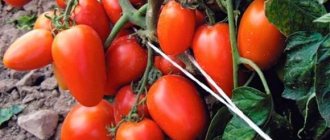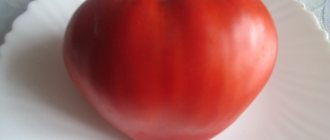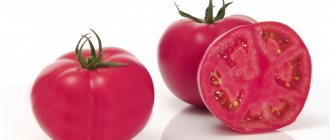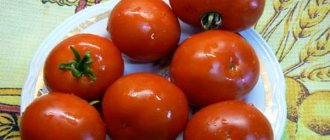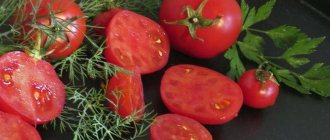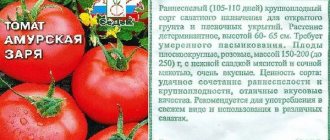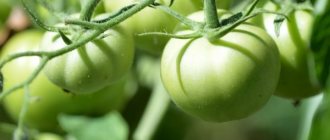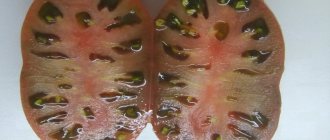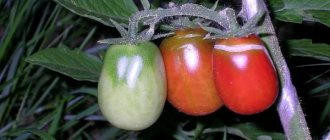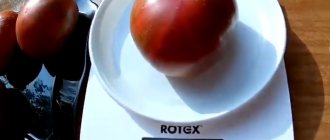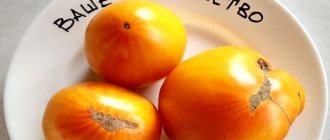The Supersteak F1 tomato passed the test for endurance, taste and productivity “excellent”. With so many varieties around, it's not easy to be the best. But the hybrid managed to take a leading position in the list of fleshy and large-fruited tomatoes.
| Height | Landing location | Ripening time | Fruit color | Fruit size | Origin | Fruit shape |
| Tall | Greenhouse, Open ground | Mid-season | Pink | Large | Hybrid | Flat-round |
Tomato Supersteak - description and characteristics of the variety
The hybrid was bred not without reason a long time ago by domestic breeders and became widespread throughout the vast Russian territory. The variety was appreciated by domestic gardeners due to its unpretentiousness, high yield and the potential to use these tomatoes in various ways - to prepare salads, prepare juice, ketchup and canning.
Description
Gardeners know that before planting and cultivating new varieties, it is useful to find out more about it in the spirit - look at reviews, listen to the opinions of experts, quote the impressions of those who have already planted this crop published on the Internet. And, you always need to know the characteristics at least in general terms. Here are the most basic ones.
- It grows and develops in any climate, suitable for cultivation in any region, but it is recommended to plant only in enclosed spaces - heated greenhouses, or, obviously, under a film in greenhouses.
- Supersteak are mid-season tomatoes. Forging of fruits ends approximately 3.5 months after the seeds were planted in the ground. You can now pick tomatoes from the bush after 100-105 days.
- Plants grow on average 1.5-1.6 meters, although many summer residents say that sometimes the height of the bush reaches 2 meters.
- Up to 8 brushes can form on top of the bush.
- The fruits are quite large, the average is 450-500 grams, there are often cases when the berry weighed around a kilogram.
- The miracle berry is full-bodied, there are no voids, the pulp is dense.
- The color is dark red.
- The husk is thick, smooth, without roughness.
Seedling growing method
- Supersteak is grown using the seedling method; mouras are planted in early March. They must first be treated in a weak pink solution of potassium permanganate aloe, then washed with running water and dried.
- It is recommended to bury it in the ground for 2-2.5 centimeters, the maximum you can bury is 3.
- As soon as another leaf forms, the seedlings can be planted, that is, planted in different containers.
- In (then the seedlings grow and gain strength, they are fed 2-3 times. For feeding purposes, a complex of nitrogen-phosphate fertilizers is usually used, intended for this and that.
- A week or a week and a half before planting seedlings in a suburban area, they need to be hardened off. To do this, the sprouts are taken out onto the balcony every day, first for a few minutes, then the minute increases, and every day it becomes more and more. After all, in recent centuries, seedlings can be outdoors all day. This is done so that the culture gets used to the climate in which it is sufficient to grow, and adapts to natural conditions.
- Seedlings are planted in April or May, when it is warm, depending on the climatic conditions of the region. On average, seedlings should be present for at least 2 months, or more precisely, they should be 90-95 days old.
- You need to cut so that there is enough space around the bushes for further growth and development, and they do not interfere with each other. It is good to have 6 plants per square meter. Since the article is determinate and constantly growing, you need to pinch off the top shoots, not allowing the bush to ascend. It is also worth trimming the lower leaves.
- It is better to limit the brush, leaving it with a maximum of 8 ovaries.
- It is recommended to water tomatoes 3-4 times a week. For irrigation, it is better to use warm water that has settled in barrels outside.
- After (one year) of watering, the soil must be loosened if the surface dries out and turns into a hard crust that does not allow air to pass through.
- The plant needs to be fed 2 or 3 times using mineral fertilizers.
Diseases and pests
The Supersteak tribe is a hybrid tribe, so immunity to the main diseases that the ass suffers from - late blight, cladosporiosis, nematode, and so on - is quite high. The crop can be easily protected from other diseases using special treatments. So, even if the bush is not protected from one of the diseases, it is simply the leaves or the tomato itself that suffer, so the problem is easily solved. Likewise, with the help of treatments it is possible to combat pests that attack nightshades.
Use
Supersteak tomatoes are very good fresh - they are eaten straight from the bush or added to salads. The fruits are very suitable for canning - due to their size, they are often placed in a jar. But they make delicious tomato chyle and make ketchups and sauces.
Video: 9 secrets of a good tomato harvest
Features of planting, growing and care
Requirements:
- the soil should be sandy and loamy;
- the soil is enriched with humus;
- earth – neutral;
- wind protection is required;
- when planting, the soil should be well heated;
air humidity should not exceed 60%; temperature range – from 20 to 25 degrees.
Time for sowing:
- for seedlings in containers - February 26 - March 10;
- when sowing in the ground, but under film - April 11 - May 1;
- for late planting in the garden - May 1-5.
How to plant seeds for seedlings?
Preparation of seed material begins approximately 2 months before transferring the bushes to open ground. Seeds require special processing, which eliminates the incidence of disease. To do this, they are placed in a manganese solution for 15-20 minutes. Next, to plant tomatoes for seedlings, you need to adhere to the following rules:
- the soil should be moist and slightly compacted;
- distance between seed material – maximum 4 cm;
- Each seed must be carefully pressed;
- the temperature before the formation of sprouts should not be lower than 25 degrees;
- after emergence of seedlings, the temperature decreases (20-22 degrees);
- Picking seedlings into separate containers is carried out after 3 leaves are formed on the bush.
How to plant seedlings and care rules
Seedlings are transplanted only when there is no risk of frost, since the plant is considered heat-loving. Rules:
- The seedlings should have a height of 28-30 cm and be up to 60 days old.
- The number of formed leaves is from 6 to 8.
- The leaf part should be saturated with a green tint. There should be no stains, damage or wrinkles on it and the stems.
- Before transplanting, the roots are carefully inspected (deformations are excluded).
- Planting in the ground is carried out in rows or in a checkerboard pattern.
- The holes are dug at a distance of 50-60 cm from each other.
Inter-row width – 50 cm.
In greenhouse conditions, frequent ventilation is required, but so that the plants do not get blown, since they do not like wind. Optimal temperature and humidity levels must be maintained.
On open ground in dry, hot weather, the Supermodel must be moisturized every day. If the summer is excessively rainy, then to eliminate the risk of disease, it is necessary to make grooves from each hole that will drain water.
Watering rules:
- watering is carried out between the rows under the horse system;
- moistening should be carried out to a depth of 35-40 cm.
Feeding:
- The first time feeding seedlings is done a couple of weeks after transplanting to a permanent place. Feeding with potassium and phosphorus is used.
- Secondary feeding is carried out after a month. Complex fertilizers are applied. For example, Nitrophoska and the like.
- Next time (in another month) you need to add potassium and nitrogen.
Diseases and pests
Control of pests and diseases that are dangerous for the Supermodel:
Phomasis disease. Treatment is carried out using Hom
Along with this, it is important to remove and destroy affected tomatoes. And also reduce the amount of watering and application of nitrogen fertilizers
For dry spotting, Tattoo, Consento, Antrakol are used. The variety is actively attacked by Colorado potato beetles. Prestige, Apache, Aktara, Taboo, Regent, Corado, Lightning, Commander are used against them.
It is important to carry out preventive measures, including the following:
- compliance with crop rotation and irrigation regime requirements;
- weed removal;
- trimming the lower leaves;
- lack of thickening during planting;
- timely loosening and fertilization;
- treatment of seedlings before transplantation with Bordeaux solution;
- adding copper oxychloride;
- adding ash to the soil.
The best varieties of tomatoes for 2021: photos and descriptions
When choosing tomatoes for their plot, gardeners, first of all, rely on varietal or hybrid characteristics. Productivity is the most important criterion on which the quantity and quality of the harvest depends. Sometimes it can be difficult to choose the right option from the rich variety of tomatoes for open ground and greenhouses. Then varieties are selected depending on the growing region, ripening period, degree of disease resistance and other factors.
Varieties for open ground
A huge number of species with excellent yields are intended for growing vegetables in the open air. Low-growing bushes with large fruits are one of the advantages of tomatoes for the soil. Such heat-loving plants are easier to care for and do not require complex agricultural practices.
According to ripening period
Tomatoes, like other vegetable crops, are characterized by different ripening periods, from early to late.
| Ripening period | Ripening of fruits after the appearance of the first shoots | general characteristics | The most productive tomatoes (2020) |
| Ultra-early ripening | On day 80-85 | The fruits are small, juicy, and low in sugar. The height of the bush is no more than 50 cm. Not suitable for preservation. | Little Red Riding Hood, Pride of Russia, Benito, Superstar, Valentina, Marisha, Maksimka |
| Early ripening | For 90-95 days | Small, delicate fruits, average yield. Suitable for canning and salads. Bushes grow up to 70 cm | Agatha, Riddle, Augustine, Lyana, Sanka, Buyan, Lakomka, Amur standard, Grandmother's kiss |
| Mid-early | On days 100-103 | The fruits are juicy, small, aromatic. The purpose is universal. Bush shape - compact | Openwork, Babushkino, Pulka, Red Giant, Russian Soul, Cardinal, Flamingo |
| Mid-season | On day 100-115 | High taste, excellent yield. There are both low-growing and tall varieties | Scarlet Candles, Hybrid Basket, Stresa, Intuition, Black Baron, Pudovik, Pink Honey |
| Late ripening | On day 120-130 | Excellent fruit taste, high yield, universal purpose. Good keeping quality and transportability of fruits | Giraffe, Cosmonaut Volkov, Titan, Rio Grande, Russian size, King of Kings, Rocket, Premier |
Description of the Supersteak tomato variety and its yield and cultivation
Tomato Supersteak f1 is a new generation hybrid that is very common in Russia. Despite the fact that the selection is young, it has already won many positive reviews.
Description of the variety
The Supersteak tomato can grow in any weather conditions and is perfect for glazed and unheated film shelters . It is considered mid-season: from germination to harvesting the first fruits 100-110 days. The plant is vigorous and can reach up to two meters.
Tomato supersteak description of variety photo reviews
Tomato Supersteak f1 is a new generation hybrid that is very common in Russia. Despite the fact that the selection is young, it has already won many positive reviews.
Description of the variety
The Supersteak tomato can grow in any weather conditions and is perfect for glazed and unheated film shelters . It is considered mid-season: from germination to harvesting the first fruits 100-110 days. The plant is vigorous and can reach up to two meters.
During growth, up to eight brushes are formed. Fruit set occurs 15 days earlier than other mid-season hybrids. This is an excellent indicator, since this tomato is also considered large-fruited. During cultivation, it is better to use pinching in two stems, then there will be more fruits and the plant will become stronger.
Supersteak fruits are beautiful, large, red in color. They have no voids inside. On average, a tomato weighs 450 grams, the maximum weight can be about a kilogram. The pulp is dense, juicy, with a sweet, slightly sugary taste. What pleases gardeners most is that large fruits go well with high yields.
You can use tomatoes raw. Due to its large size, the whole fruit is not suitable for preservation, but they can be used in tomato juice, adjika and a variety of salads.
Growing Supersteak tomatoes
For seedlings, seeds are planted in March, the maximum burial depth is three centimeters. Before doing this, you need to treat them in potassium permanganate and then rinse with clean water. Don’t forget to feed the seedlings two or three times with special fertilizer. Supersteak tomatoes require seedlings to be hardened off before being planted in the ground.
Since they can only be grown in greenhouses, temperature standards must be observed. If the greenhouse has heating, then planting can be done in April. And if the greenhouse is not heated, then not earlier than May. The seedlings must be at least 65 days old.
You cannot plant bushes next to each other, as they will only interfere with each other. Oddly enough, but you need to limit the growth of the plant only upwards, otherwise they can grow greatly. That is why it is worth leaving a maximum of eight brushes on the bush. The lower leaves must be cut off.
Remember to regularly water the bushes only with warm water. If you decide to feed the plant, it is better to use special complex water-soluble mineral fertilizers. They are considered the most harmless.
Diseases
Due to the fact that the Supersteak variety is considered a hybrid, it has genetic resistance to late blight, TMV, cladosporiosis, bacterial spot and root-knot nematode. All other tomato diseases can be easily controlled with the help of special fertilizers and treatments.
Basically, not the whole plant suffers from various diseases, but only the fruits or leaves. The affected parts are easily removed and the tomatoes continue to grow.
Supersteak tomatoes are considered one of the most unpretentious to grow.
Many gardeners are interested in how to grow Supersteak tomatoes. Tomatoes are grown in every summer cottage, as they can be used for making fresh salads, tomato juice and for canning. This healthy vegetable is a source of microelements and vitamins, which is why summer residents plant various varieties of it in their gardens.
Tomatoes must be chosen for the garden so that they grow and bear fruit. It is recommended to take into account planting conditions, climatic features of the region, temperature changes, resistance to diseases and infections. It is also important to read reviews about the selected variety.
Description of Supersteak tomato
Many summer residents prefer hybrid varieties that can grow in difficult weather conditions and be resistant to parasites. This variety is the Supersteak f1 tomato.
Reviews about this tomato will be discussed below. Scientists-breeders have created a variety of tomatoes so that it bears fruit and is resistant to climate change.
Among the main characteristics that Supersteak tomatoes have, it is worth noting the following:
- It grows under any conditions, so bushes can be planted in open areas, in greenhouses or in unheated shelters made from film.
- Refers to mid-season varieties. The fruits begin to ripen 3.5 months after planting the seeds in the ground. After 100, maximum 110 days, you can harvest tomatoes from the bushes.
- The height of the plants, according to reviews, is 2 m, although summer residents note that the bushes can have a smaller height, which varies between 0.8-1 m.
- Clusters of fruits form during bush growth. There can be up to 8 brushes on one plant. The ovary of Supersteak tomatoes forms 2 weeks earlier than in other hybrid varieties.
- Cultivation should be carried out by pinching 2 stems, which will allow you to get more fruits and a strong bush.
Diseases
Due to the fact that the Supersteak variety is considered a hybrid, it has genetic resistance to late blight, TMV, cladosporiosis, bacterial spot and root-knot nematode. All other tomato diseases can be easily controlled with the help of special fertilizers and treatments.
Basically, not the whole plant suffers from various diseases, but only the fruits or leaves. The affected parts are easily removed and the tomatoes continue to grow.
Supersteak tomatoes are considered one of the most unpretentious to grow.
What is a Supersteak tomato, description and cultivation
Many gardeners are interested in how to grow Supersteak tomatoes. Tomatoes are grown in every summer cottage, as they can be used for making fresh salads, tomato juice and for canning. This healthy vegetable is a source of microelements and vitamins, which is why summer residents plant various varieties of it in their gardens.
Tomatoes must be chosen for the garden so that they grow and bear fruit. It is recommended to take into account planting conditions, climatic features of the region, temperature changes, resistance to diseases and infections. It is also important to read reviews about the selected variety.
Description of Supersteak tomato
Many summer residents prefer hybrid varieties that can grow in difficult weather conditions and be resistant to parasites. This variety is the Supersteak f1 tomato.
Reviews about this tomato will be discussed below. Scientists-breeders have created a variety of tomatoes so that it bears fruit and is resistant to climate change.
Among the main characteristics that Supersteak tomatoes have, it is worth noting the following:
- It grows under any conditions, so bushes can be planted in open areas, in greenhouses or in unheated shelters made from film.
- Refers to mid-season varieties. The fruits begin to ripen 3.5 months after planting the seeds in the ground. After 100, maximum 110 days, you can harvest tomatoes from the bushes.
- The height of the plants, according to reviews, is 2 m, although summer residents note that the bushes can have a smaller height, which varies between 0.8-1 m.
- Clusters of fruits form during bush growth. There can be up to 8 brushes on one plant. The ovary of Supersteak tomatoes forms 2 weeks earlier than in other hybrid varieties.
- Cultivation should be carried out by pinching 2 stems, which will allow you to get more fruits and a strong bush.
Thus, these tomatoes have excellent performance, which allows them to be grown in greenhouses or in open ground.
Separately, it is worth mentioning the fruits of tomatoes of the Supersteak f1 variety, which are large. The average weight of 1 fruit varies between 0.4-0.5 kg, although reviews from breeders indicate that tomatoes can reach 1 kg. The fruits are distinguished by the fact that there is no emptiness inside, the pulp is quite dense and juicy.
Tomatoes have a sweet, slightly sugary taste. Such large fruits are used mainly for creating salads, preparing adjika, tomato juice, and canned salads. In its entirety, it is not always possible to close the Supersteak, since the fruits are large and do not fit in a jar, although the tomatoes are suitable for pickling in a barrel.
Advantages of this variety:
- excellent combination of high fertility and large fruit;
- resistance to weather changes, which allows you to grow crops at any time of the year;
- resistance to plant diseases such as late blight, bacterial spot, root-knot nematodes, cladosporiosis.
Growing Supersteak Tomatoes
In order for this variety of tomatoes to take root in your summer cottage, you need to adhere to the rules for planting and caring for it:
- Before planting, treat the seeds in a weak solution of potassium permanganate, and then rinse them in clean water.
- Seeds should be planted in March, buried 3 cm in the ground.
- Purchase fertilizers for the Supersteak variety in the store to regularly feed the plant.
Tomatoes should be planted during April-May. If there is heating in the greenhouse, seedlings are placed in the soil in April, but if there is no heat, then you need to wait until May. The average age of seedlings before planting should be 2 months (within 65 days).
Bushes are not planted nearby so that they have plenty of freedom to grow and do not interfere with each other. When the clusters begin to form, the lower leaves should be trimmed. This will limit the growth of the bushes, otherwise they can grow large, this will take away the strength of the plant, and the fruits will turn out small and pointed.
Features of cultivation and care
Growing a “Honey Drop” tomato, like any other type of tomato, involves sequentially performing the following steps:
- Sowing seeds and growing seedlings.
- Planting plants in the ground.
- Regular and proper care of tomatoes, as well as timely harvesting.
Let us consider all the above positions in more detail regarding the “Honey Drop” variety.
Sowing seeds and growing seedlings
Seeds of the Honey Drop variety have good germination. The optimal period for sowing is the end of March.
Seeds are sown in previously prepared and moistened soil. The seed is placed to a depth of 1-2 cm. Then the container with the newly planted seeds is covered with a layer of film and placed in a warm place.
The first shoots of the Honey Drop variety appear after 1-1.5 weeks. After the true leaves appear, the plants can be pruned. Picking is necessary for further proper growth of the bush and effective fruiting.
Advice! In the process of picking a plant, it is necessary to lightly pinch the main root of the plant.
This is necessary for the development and growth of lateral roots, which leads to the development of the root system and, as a consequence, the entire plant as a whole.
Planting plants in the ground
The “Honey Drop” variety, according to its main characteristics, can be planted both in a greenhouse and directly in the garden bed. The planting location is selected based on the individual preferences of the vegetable grower, as well as the climatic characteristics of the region.
Important! When planting seedlings in open ground, it is necessary to pre-harden the seedlings. To do this, the bushes with tomatoes are first taken outside for several hours, and then, after a couple of days, left in the fresh air for the whole night.
To do this, the bushes with tomatoes are first taken outside for several hours, and then, after a couple of days, left in the fresh air for the whole night.
Seedlings are planted after spring frosts, usually at the end of May. Plants are planted according to the 40x70 pattern in preheated soil (when planting in a greenhouse) and relatively low air humidity.
Regular proper tomato care
Caring for the Honey Drop tomato variety includes:
- timely watering;
- regular loosening of the soil and removal of weeds;
- feeding the plant;
- constant garter of the bush as it grows;
- regular removal of side shoots and foliage to shorten the ripening period and improve the taste of the tomato;
- timely harvest.
